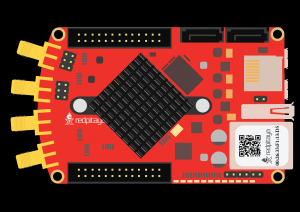2.3.6.3.2. Generate signal pulses
2.3.6.3.2.1. Description
This example shows how to generate signal pulses of predefined signal waveforms like sine, triangle, square, ramp up, ramp down, or PWM. A generated signal can be observed by an oscilloscope.
2.3.6.3.2.3. SCPI Code Examples
2.3.6.3.2.3.1. Code - MATLAB®
The code is written in MATLAB. In the code, we use SCPI commands and TCP client communication. Copy the code from below into the MATLAB editor, save the project, and hit the “Run” button.
%% Define Red Pitaya as TCP client object
clc
clear all
close all
IP = '192.168.178.111'; % Input IP of your Red Pitaya...
port = 5000; % If you are using WiFi then IP is:
RP = tcpclient(IP, port); % 192.168.128.1
RP.ByteOrder = "big-endian";
configureTerminator(RP, "CR/LF");
% Reset Generation
writeline(RP,'GEN:RST');
%% GENERATION
writeline(RP,'SOUR1:FUNC SINE');
writeline(RP,'SOUR1:FREQ:FIX 1000'); % Set frequency of output signal
writeline(RP,'SOUR1:VOLT 1'); % Set amplitude of output signal
writeline(RP,'SOUR1:BURS:STAT BURST'); % Set burst mode to ON (Red Pitaya will
% generate R number of N periods of signal and then stop.
% Time between bursts is P.)
writeline(RP,'SOUR1:BURS:NCYC 1'); % Set 1 (N) pulses of sine wave
writeline(RP,'SOUR1:BURS:NOR 10000'); % (R) number of sine wave pulses (set to 65536 for INF pulses)
writeline(RP,'SOUR1:BURS:INT:PER 5000'); % Set time (P) of burst period in microseconds = 5 * 1/Frequency * 1000000
writeline(RP,'OUTPUT1:STATE ON'); % Set output to ON
writeline(RP,'SOUR1:TRig:INT'); % Set generator trigger to immediately
%% Close connection with Red Pitaya
clear RP;
2.3.6.3.2.3.2. Code - Python
Using just SCPI commands:
#!/usr/bin/env python3
import sys
import redpitaya_scpi as scpi
IP = 'rp-f066c8.local'
rp_s = scpi.scpi(IP)
wave_form = 'sine'
freq = 1000
ampl = 1
rp_s.tx_txt('GEN:RST')
rp_s.tx_txt('SOUR1:FUNC ' + str(wave_form).upper())
rp_s.tx_txt('SOUR1:FREQ:FIX ' + str(freq))
rp_s.tx_txt('SOUR1:VOLT ' + str(ampl))
rp_s.tx_txt('SOUR1:BURS:STAT BURST') # activate Burst mode
rp_s.tx_txt('SOUR1:BURS:NCYC 1') # Signal periods in a Burst pulse
rp_s.tx_txt('SOUR1:BURS:NOR 10000'); # Total number of bursts (set to 65536 for INF pulses)
rp_s.tx_txt('SOUR1:BURS:INT:PER 5000'); # Burst period (time between two bursts (signal + delay in microseconds))
rp_s.tx_txt('OUTPUT1:STATE ON')
rp_s.tx_txt('SOUR1:TRig:INT')
rp_s.close()
Using functions:
#!/usr/bin/env python3
import sys
import redpitaya_scpi as scpi
IP = 'rp-f066c8.local'
rp_s = scpi.scpi(IP)
wave_form = 'sine'
freq = 10000
ampl = 1
rp_s.tx_txt('GEN:RST')
# Function for configuring a Source
rp_s.sour_set(1, wave_form, ampl, freq, burst=True, nor=10000, ncyc=2, period=5000)
# nor=65536 for INF pulses
rp_s.tx_txt('OUTPUT1:STATE ON')
rp_s.tx_txt('SOUR1:TRig:INT')
rp_s.close()
Note
The Python functions are accessible with the latest version of the redpitaya_scpi.py document available on our GitHub. The functions represent a quality-of-life improvement as they combine the SCPI commands in an optimal order and also check for improper user inputs. The code should function at approximately the same speed without them.
For further information on functions please consult the redpitaya_scpi.py code.
2.3.6.3.2.4. API Code Examples
Note
The API code examples don’t require the use of the SCPI server. Instead, the code should be compiled and executed on the Red Pitaya itself (inside Linux OS). Instructions on how to compile the code and other useful information are here.
2.3.6.3.2.4.1. Code - C API
/* Red Pitaya C API example pf Generating signal pulse on an external trigger */
#include <stdio.h>
#include <stdlib.h>
#include <unistd.h>
#include "rp.h"
int main(int argc, char **argv){
/* Print error, if rp_Init() function failed */
if(rp_Init() != RP_OK){
fprintf(stderr, "Rp api init failed!\n");
}
* Reset Generation */
rp_GenReset();
/* Generation */
rp_GenWaveform(RP_CH_1, RP_WAVEFORM_SINE);
rp_GenFreq(RP_CH_1, 1000);
rp_GenAmp(RP_CH_1, 1.0);
rp_GenMode(RP_CH_1, RP_GEN_MODE_BURST);
rp_GenBurstCount(RP_CH_1, 1);
rp_GenBurstRepetitions(RP_CH_1, 10000); // set to 65536 for INF pulses
rp_GenBurstPeriod(RP_CH_1, 5000);
rp_GenOutEnable(RP_CH_1);
rp_GenTriggerOnly(RP_CH_1);
/* Releasing resources */
rp_Release();
return 0;
}
2.3.6.3.2.4.2. Code - Python API
#!/usr/bin/python3
import time
import rp
#? Possible waveforms:
#? RP_WAVEFORM_SINE, RP_WAVEFORM_SQUARE, RP_WAVEFORM_TRIANGLE, RP_WAVEFORM_RAMP_UP,
#? RP_WAVEFORM_RAMP_DOWN, RP_WAVEFORM_DC, RP_WAVEFORM_PWM, RP_WAVEFORM_ARBITRARY,
#? RP_WAVEFORM_DC_NEG, RP_WAVEFORM_SWEEP
channel = rp.RP_CH_1 # rp.RP_CH_2
waveform = rp.RP_WAVEFORM_SINE
freq = 1000
ampl = 1
ncyc = 1 # Number of waveform periods in one burst
nor = 1000 # Number of repeated bursts
period = 5000 # Delay between start of first burst and start of second burst
# in mircoseconds
#? Possible modes:
#? RP_GEN_MODE_CONTINUOUS, RP_GEN_MODE_BURST
mode = rp.RP_GEN_MODE_BURST
# Initialize the interface
rp.rp_Init()
# Reset generator
rp.rp_GenReset()
###### Generation #####
rp.rp_GenWaveform(channel, waveform)
rp.rp_GenFreqDirect(channel, freq)
rp.rp_GenAmp(channel, ampl)
# Change to burst mode
rp.rp_GenMode(channel, mode)
rp.rp_GenBurstCount(channel, ncyc) # Ncyc
rp.rp_GenBurstRepetitions(channel, nor) # Nor
rp.rp_GenBurstPeriod(channel, period) # Period
# Enable output and trigger the generator
rp.rp_GenOutEnable(channel)
rp.rp_GenTriggerOnly(channel)
# Release resources
rp.rp_Release()

